Tag: Wes Hagen
Spring in the Vineyard
Cab Franc vines, still protected by mounds of dirt, showing exuberant growth before being un-hilled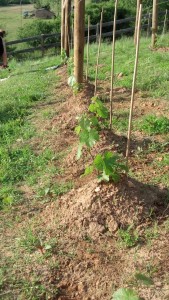
Despite months of crazy weather, it's finally springtime in the vineyard. And after all the hours of planning and research and all the work that went into getting the vineyard ready for planting vines – not to mention the planting itself – I was pretty bummed about not getting to see the early fruits of our labor this weekend. My wife, Chris, ably assisted by daughter Kate, the vineyard volunteer worker, traveled to Afton without me this weekend to un-hill new vines, continue the work on the deer fence, and handle a dozen other tasks that demand attention in the spring.
So, this isn’t exactly an eyes-on report from the scene. It’s more like something cobbled together by an editor hunkered down in a newsroom, piecing together a story out of dispatches sent in by reporters from the front lines. I've been both a reporter and an editor in my life, and believe me, being a reporter is way more fun. Editors sit behind desks in newsrooms waiting for reporters to tell them what’s going on. When I was an editor, I generally got cranky while waiting. Reporters get out of the office and see things happen. Even in the day of Blackberries and instant communication, I'm sure they still keep editors at bay during the day by telling them there’s way too much going on to stop and talk. And they’re usually right.
Petit Verdot vines after removal of the earth mounds, or hills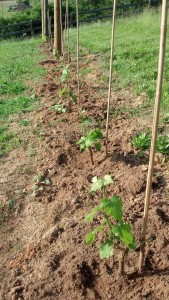
In this case, Chris and Kate filed their dispatches by text messages, emailed pictures, and a number of old-fashioned cell-phone calls, all of which provided some color on the early progress our vines are making. I have to say, we’re just thrilled with the results. Out of the 150 vines we planted this spring, only one appears to be clearly dead, according to the reports I've received, although another ten are doubtful. But the rest look magnificent! (Especially in the pictures.)
I’m particularly pleased with the progress of the first group of Cabernet Franc vines that we transplanted from our Fairfax vineyard two weeks ago. They not only survived, but they’re flourishing. And they have fruit! Big clusters of berries that will turn into grapes very soon if we leave them on the vine. Which, of course, we won’t. Even if the vines hadn’t been through the shock of being dug up in Fairfax and replanted in Afton, they’re still only in their second year of life, and they needto devote all of their energy to developing a strong root system and trunk. So we’ll be dropping the fruit soon.
Clusters of berries that would eventually be Cab Franc wine grapes if we let them continue to mature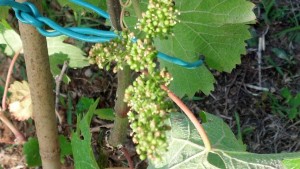
We had planted seven Cab Franc vines in Fairfax a year ago, all for the purpose of getting additional hands-on experience working with vines. This weekend, Chris dug up the last three and moved them, so the Fairfax “vineyard” is officially defunct, although it lives on in spirit in Nelson County. We can’t be sure that all seven will make it, but we’re very hopeful.
Cab Franc vines still in transplant shock from being moved on May 19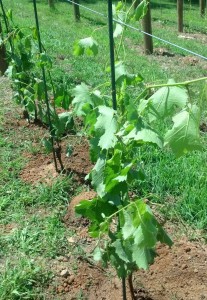
In any event, I'm glad we tried this experiment, which was prompted by an article by WineMaker’s magazine’s Wes Hagen. He recommended ordering extra vines and planting the excess closely together on some spare land. That way, you have some surplus vines to replace the ones that inevitably will die. And that’s one of the sad facts of viticulture. No matter how good you are, no matter how carefully you plant, and no matter how great the nursery you buy from, you’re going to lose some plants. So, even though some of the 50 Cab Franc vines that we planted this year will surely die, with the additional one-year old vines Fairfax we should end up ahead of the game. Wish I had read the Wes Hagen advice before we ordered vines for planting this year.
Looking at the rest of the vinyeard, our whites are doing quite well. We planted 25 each of Petit Manseng and Viognier on the weekend of March 31, and mounded hills of earth over them, covering the graft union with about two inches of soil to protect the dormant vines from the possibility of late frost. We un-hilled them two weekends ago on May 6, and they have been doing quite well ever since.
Close up of a Petit Manseng vine that was planted April 21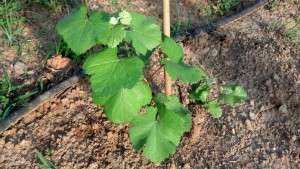
Likewise, the reds are showing great promise. Chris and Kate un-hilled the 100 Cab Franc and Petit Verdot vines that we planted over three days in early April. Both grapes seem to do well in Virginia, and we are wildly optimistic about their potential. Which, of course, puts us in the company of farmers everywhere who start each spring full of optimism, no matter how bad the previous year went. And don’t get anyone started talking about the 2011 vintage. Trust me, just don’t.
A row of Viognier vines - all healthy so far!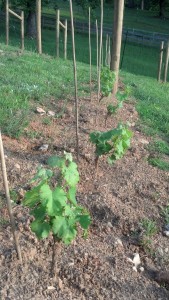
By the way, the un-hilling I did two weeks ago involved a lot of careful work with my hands, but it was positively crude compared to Chris’s method. I pushed the dirt aside a little bit at a time, until the vine was completely uncovered. Okay, maybe a spare bud or two got knocked off in the process.
Chris would have none of that. She bought a makeup brush for the final removal of soil from the vines, and claims it worked like a charm. I wasn’t there, so I’ll take her word for it. It seems like a pretty time-consuming approach, so I’m pretty confident that I’ll do my part of the un-hilling next year sans the makeup brush. Unless of course the vines she un-hilled do better than mine. Let’s not even go there, okay?
And there’s still so much work to be done. I think I’m recovering well enough from surgery that I’ll be able to be in Afton myself for the next trip. Chris and Kate have gotten to be quite the dedicated and skilled vineyard workers, handling everything from driving posts into the ground to planting vines. I’d sure like to be able to lend a hand. Or at least be there to watch with great enthusiasm while they do the work
The Great Experiment — Transplanting Cab Franc
Another busy weekend in the vineyard. We transplanted four Cab Franc vines from Fairfax, researched and ordered a deer fence, and installed the bottom, or fruiting wire on our trellises in Afton. And, of course, we spent some time admiring the fruit of our labors from the previous few weeks – 150 new vines buried under mounds of dirt. The reds, which
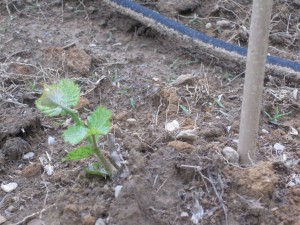
Three weeks after planting, the Viognier, pictured here, and the Petit Manseng, are emerging from the mounds of dirt that protected them from the spring frosts.
we planted two weekends ago, were still hidden away, but the whites we planted a week earlier – the Petit Manseng and the Viognier – were poking through the hills, and we were just thrilled to see them pushing through the earth! I have to say, they emerged from the mounds at just the right time, avoiding the frost that killed off our two prize Mammolo Toscano vines the previous weekend. Frost is an issue that we’ve been giving a lot of thought to after our experience this winter, and it influenced our decision on where to locate the fruiting wire. More on that in a future post.
For today, I’ll simply focus on our grand experiment, the transplanting of four of our Cab Franc vines from Fairfax to the Afton vineyard. We had planted a total of seven Cab Francs in Fairfax to get a bit of hands on experience close to home. I suppose at the back of my mind I thought I might eventually make a little wine from those vines, but mostly I
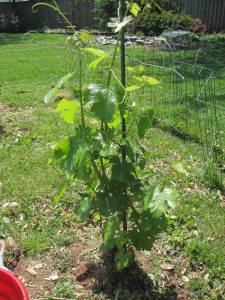
The Fairfax vines looked magnificent this Spring -- if a bit unruly. They need to be pruned, but that, I decided, would wait until they reached their new home.
wanted the experience of being able to go out in the evening after work to care for them and learn from that effort. We planted another five of the same clone and rootstock in Afton to see how the same vines would do in a different environment.
The Fairfax vines grew fast and they looked just beautiful. Clearly, the soil in Fairfax is rich, lending itself to high vigor growth. That’s good and bad, but probably mostly bad. It’s great to see the vines shoot up quickly, but ideally, we’d like them to struggle a bit so that the energy of the plant goes toward the grapes, not the vine itself. Left to its own, the vine will grow as high as it can find support – up a tree, for example, pushing toward the sunlight – but spectacular as that vine might be, Continue Reading–>
Planting the Vineyard, Part I
With the trellis posts finally in the ground, we were finally ready to plant. And not a moment too soon.
When we arrived in Afton on Friday evening, March 30, we had 50 dormant vines waiting for us: 25 Petit Manseng from Vintage Nurseries in Wasco, California, and 25 Viognier from Sunridge Nurseries, Bakersfield, California. The largest number of vines we had ever planted before was seven, and we weren’t sure how long it would take to get
these vines in the ground, or even if we’d be able to get it done by the end of the weekend. But we had another 100 vines set to arrive the following weekend, which meant we didn’t have much of a choice. We decided to plant the Petit Manseng first, and prepared them by putting them in a bucket of water to soak overnight.
In the morning, we inspected the vines to see if they looked healthy. This was kind of like the time in high school when my car wouldn’t start as I was taking my date home. I opened the hood, looked inside as though I knew what I was doing, and just prayed it would start when I got back in the car. It did start up, Continue Reading–>

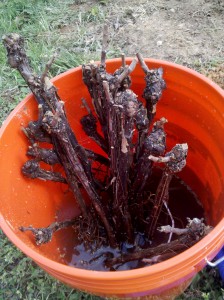


Recent Comments